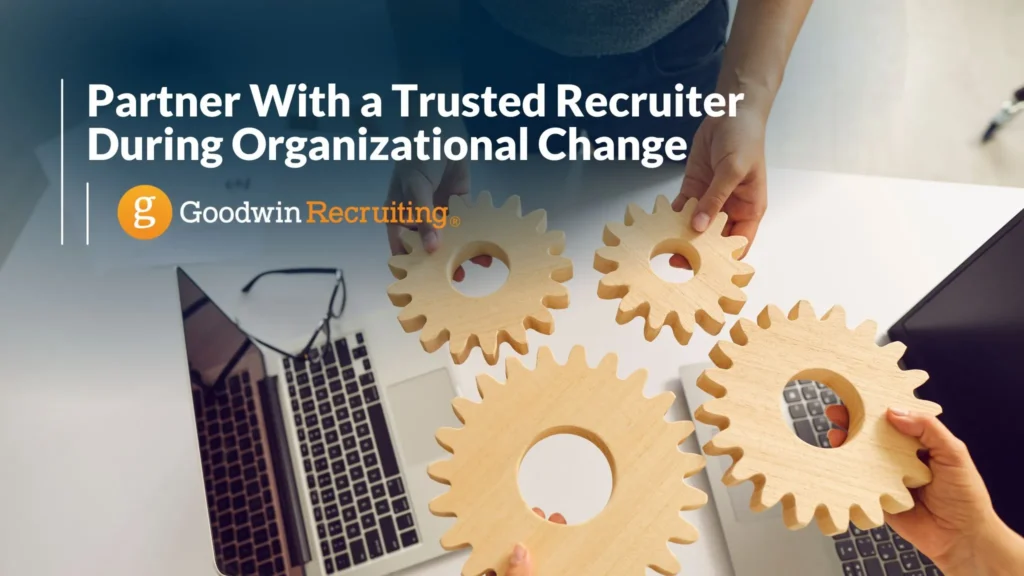The Benefits of Keeping an Open Mind with Job Candidates

In the talent recruiting world, it’s common for clients to come to us with specific candidate requirements for their open jobs. The operative word is ‘specific,’ and in many ways, this can be a good thing. Precise requirements tell us that the hiring executive or hiring manager knows exactly what they want in a job seeker, such as the level of education, type of experience, skill sets, supervisory know-how, credentials, and leadership traits. This clarity is usually accompanied by a well-defined job description, which can also be good.
By all indications, you would think such human resources preparedness would result in a quick and successful hire. But too often, this just isn’t the case. The reality is that holding fast to rigid qualifications in the search for talent is not an ideal way to come out of the hiring gate, especially in today’s candidate-driven market.
Market conditions call for a fresh hiring strategy
Keeping an open mind in the hiring process is not a new concept, but it’s certainly the best one right now and for the foreseeable future. For 25 years, Goodwin Recruiting has partnered with executives, hiring managers, job seekers, and passive candidates to connect companies with the right talent for critical roles. We know the extent to which companies are struggling to attract and retain talent today, and most of the time, we know the reasons why.
The pandemic changed so many things, from work environments to processes and operations, not to mention changing career paths, increasing job searches among existing employees, and growing demands for greater work-life balance.
We’d like to share insights into what is holding many companies back, what being open-minded means in the talent search process, and successful strategies for talent acquisition and retention in today’s job market.
Here’s how checking all the boxes can undermine hiring and retention goals
What happens when companies and hiring managers offer no flexibility for job seekers to meet job requirements? The first thing this does is dramatically shrink the pool of available talent. While narrowing the field of candidates for a role and job description seems the logical first step in the hiring process, it’s really not, or at least it shouldn’t be. We’ll explain why in a minute.
- Hidden talent: When employers restrict potential candidates to those whose job applications and resumes check all the boxes, they miss out on talented contenders whose strengths in certain areas, and even in areas beyond the job description, more than make up for a missing skill, credential, or degree (all of which are attainable!). To ensure these in-demand job seekers don’t slip away, the first step in your hiring strategy should be to prioritize your must-have requirements, as well as those you can do without for now. This is not a compromise! Instead, it’s a wise move that allows you to cast a wider net in your search for top talent, increase the viable job applications you receive, and expand internal competencies with people who can contribute on day one and grow within your organization.
- Here today, gone tomorrow: New talent retention is also an issue. Whether employers search for candidates on their own or through a recruiter, the first thing they see is a job application and a resume. We hear time and again how companies choose to interview and hire only people who are 100% matches for their job requirements, all based on resumes, only to watch those new hires job hop to the next opportunity after a short time in their roles. Re-hiring and re-training are too costly for this to occur but it is surprisingly common in our post-pandemic world. You can minimize the possibility by keeping an open mind in your talent search.
- The big contrast: We have many clients who are open to considering and hiring candidates who are an 80% match for their job descriptions and requirements. These organizations come to us with a set of specific requirements, too, but they are flexible in relaxing certain ones in exchange for exceptional candidates. In doing so, they are not taking chances or sacrificing anything that doesn’t pay them back in big ways. What they are doing is giving talented, qualified job seekers new opportunities. It’s a win-win scenario in which companies consistently find immediate and long-term success. They invest in training, upskilling, and career development, and best of all, these are the candidates who stay with their employers for years.
Look for the culture match
What really matters in talent recruitment is finding a candidate who fits in with your company culture. Skye Schooley of Business News Daily summed it up right in saying, “Cultural fit is a concept that can be hard to define, but everyone knows when it is missing. Finding employees that add to your company culture is important; as such, cultural fit should play a key role in your recruiting and hiring process.”
Yes, culture can be hard to define because it differs at every company. It is unique to each brand, their mission and values. It is incumbent on leaders to not only ensure their culture is well-defined but also understand how essential this is to prospective job seekers. A Glassdoor study reveals that there’s much more to attracting and retaining talent than compensation and benefits:
- When searching for a new job, 77% of respondents said they would consider a company’s culture before applying.
- American millennials, the largest segment of today’s workforce, are more likely to care about work culture over salary (65%).
- 89% of adults polled told researchers it was important for employers to have a clear mission and purpose.
Once your executives or hiring managers find and hire a great candidate, the goal (and big challenge today) is to keep them on board and motivated.
Jason Randall, CEO of Questco, a nationwide outsourced HR provider, shares in Forbes why a strong company culture is the best retention strategy amid high turnover.
“In a strong company culture, business leaders communicate their vision with authenticity and simplicity. In a supportive culture, leaders show gratitude and appreciation to employees, and not just by writing checks. They include workers in decision-making, listen to them, and give honest, respectful feedback. Leaders ensure the same humanity imbues all their business relationships, including those outsourced. The main cost of this strategy is the investment of time and mental energy, but that pales in comparison with the difficulty of onboarding good help in a historically tight job market,” Randall says.
Recognized as the greatest leader of his era, former CEO of General Electric Jack Welch says it even more succinctly: “No company, small or large, can win over the long run without energized employees who believe in the mission and understand how to achieve it.”
Challenge yourself to embrace flexibility and diversity
As you put together your set of needs for your next job opening, commit to welcoming candidates who are outside the mold of what you would typically consider. One way to do this is by recognizing transferrable skill sets that make for a natural transition from a different job or industry to yours. Another is to concentrate on candidates who are an ideal cultural fit for your organization and then train or upskill them once they are hired.
Perhaps one of the most substantial ways to expand your talent net is through diversity. A majority of today’s top candidates require a commitment to diversity and inclusion in a potential employer, and so does an increasingly diverse U.S. client base. More and more companies view diversity as a prerequisite to maintaining relevance in our modern world.
About those transferrable skills: In our fast-changing world, what organization can afford to say no to valuable human capital? If you continually struggle to find the right talent, it’s time to shed the status quo of restrictive job descriptions and requirements and let your roles evolve. When you find a gem of a candidate, think about how you can apply their skills within or beyond the existing job description.
Here’s a great example. One Atlanta employer recently onboarded a manager with skills the company didn’t realize they needed internally until it became evident in the interview process. Instead of turning the candidate away because his desired salary and skills didn’t perfectly align with the job, the president chose to meet with the candidate. The president not only hired him but also shaped the job around his exceptional skills. Today, the manager is helping the company better meet the needs of the business and its customers.
“Going forward, hire for aptitude and ability, and ease off of conformance with strict requirements,” says David Cooper, CEO and principal strategist for The Cooper Group consulting firm, who encourages employers to loosen up internally, too. “Today, you need everything your employees have to offer. And in turn, your people want and need to grow, to better themselves,” he says. “Unleash your rainmakers by putting their talents to work in new ways. I echo Ralph Marston of The Daily Motivator in saying that ‘Excellence is not a skill. It’s an attitude.’”
Take advantage of all resources available to you
As you work to refine your organization’s hiring strategy, you can gain invaluable benefits by partnering with an expert recruiter. One of the greatest advantages is a trusted, committed relationship in which the recruiter knows your company, your company culture, and your industry. And of course, this partnership gives you immediate access to top talent within your industry, as well as lateral markets (think transferrable skills!).
How a trusted relationship with a recruiter can come into play: One of our senior recruiting partners recently worked with a job seeker who had limited experience as a general manager. The candidate was applying for a role requiring more advanced skill sets and more years of experience. Our recruiter took the job application and scheduled an intake interview, fully expecting to explain the role was not a fit and suggest other opportunities. Once again, the interview and an open mind changed all that.
The candidate was so impressive that our recruiter submitted his resume to the client for the more advanced role. As anticipated, the client said the resume made no sense for the position but agreed to an interview because he trusted the recruiter and knew there had to be a reason. Later the same week, the client extended an offer to the candidate. Our recruiter said…
“I believed in my candidate and that the client may see what I saw and realize this candidate was exactly who they wanted – even if his resume wasn’t the one they thought they needed.”
Whatever our roles may be in the hiring world, the longer we are in it, the more we come to realize that the perfect match on paper is not always a perfect match in the long run – or even the short run!
Whether your executives and hiring managers scout talent directly or you work with a recruiter, being open-minded with job seekers can deliver your next bench of leaders. There’s a big world of talent out there with the aptitude and ability to take your organization to the next level – if you will only give them a new opportunity!
Share This Article







































